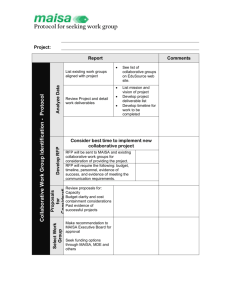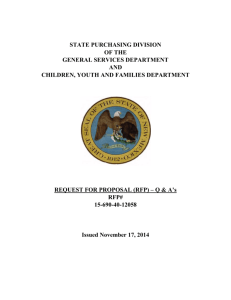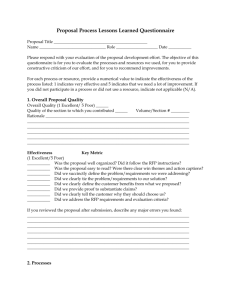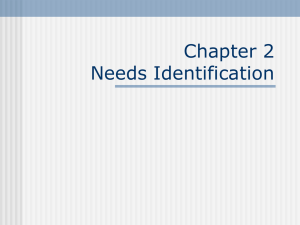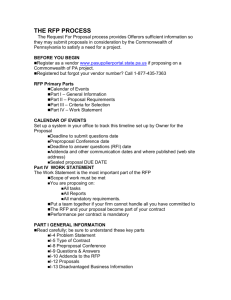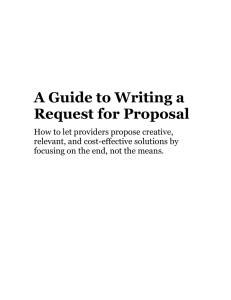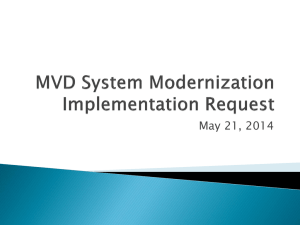Frequently Asked Questions April 7, 2014
advertisement
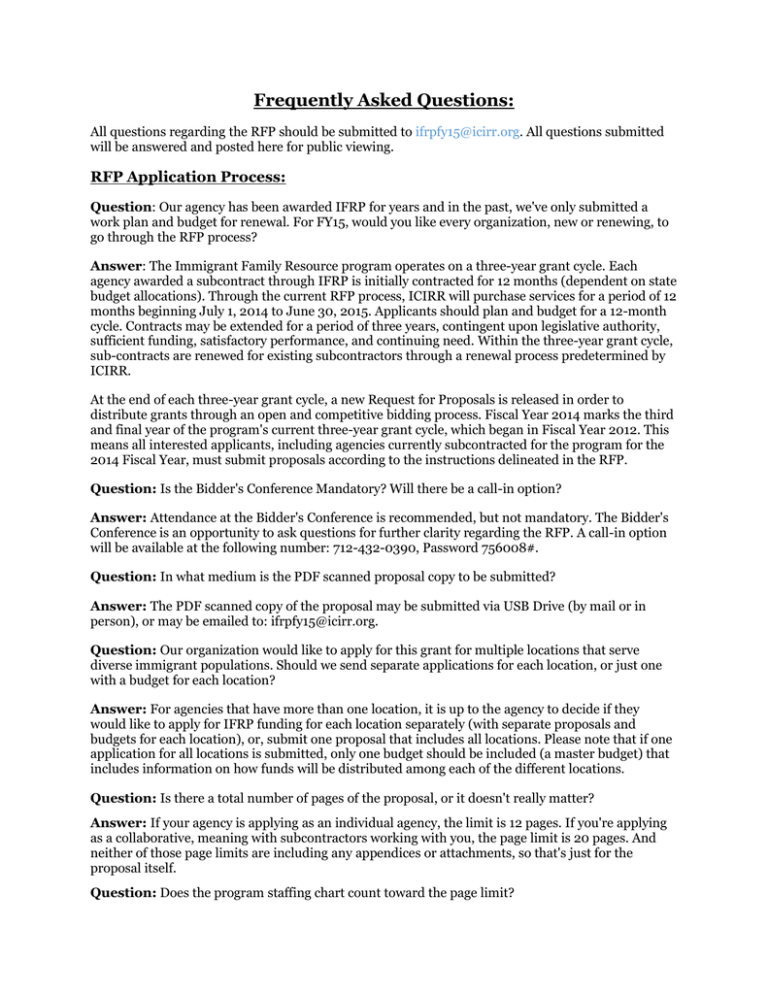
Frequently Asked Questions: All questions regarding the RFP should be submitted to ifrpfy15@icirr.org. All questions submitted will be answered and posted here for public viewing. RFP Application Process: Question: Our agency has been awarded IFRP for years and in the past, we've only submitted a work plan and budget for renewal. For FY15, would you like every organization, new or renewing, to go through the RFP process? Answer: The Immigrant Family Resource program operates on a three-year grant cycle. Each agency awarded a subcontract through IFRP is initially contracted for 12 months (dependent on state budget allocations). Through the current RFP process, ICIRR will purchase services for a period of 12 months beginning July 1, 2014 to June 30, 2015. Applicants should plan and budget for a 12-month cycle. Contracts may be extended for a period of three years, contingent upon legislative authority, sufficient funding, satisfactory performance, and continuing need. Within the three-year grant cycle, sub-contracts are renewed for existing subcontractors through a renewal process predetermined by ICIRR. At the end of each three-year grant cycle, a new Request for Proposals is released in order to distribute grants through an open and competitive bidding process. Fiscal Year 2014 marks the third and final year of the program's current three-year grant cycle, which began in Fiscal Year 2012. This means all interested applicants, including agencies currently subcontracted for the program for the 2014 Fiscal Year, must submit proposals according to the instructions delineated in the RFP. Question: Is the Bidder's Conference Mandatory? Will there be a call-in option? Answer: Attendance at the Bidder's Conference is recommended, but not mandatory. The Bidder's Conference is an opportunity to ask questions for further clarity regarding the RFP. A call-in option will be available at the following number: 712-432-0390, Password 756008#. Question: In what medium is the PDF scanned proposal copy to be submitted? Answer: The PDF scanned copy of the proposal may be submitted via USB Drive (by mail or in person), or may be emailed to: ifrpfy15@icirr.org. Question: Our organization would like to apply for this grant for multiple locations that serve diverse immigrant populations. Should we send separate applications for each location, or just one with a budget for each location? Answer: For agencies that have more than one location, it is up to the agency to decide if they would like to apply for IFRP funding for each location separately (with separate proposals and budgets for each location), or, submit one proposal that includes all locations. Please note that if one application for all locations is submitted, only one budget should be included (a master budget) that includes information on how funds will be distributed among each of the different locations. Question: Is there a total number of pages of the proposal, or it doesn't really matter? Answer: If your agency is applying as an individual agency, the limit is 12 pages. If you're applying as a collaborative, meaning with subcontractors working with you, the page limit is 20 pages. And neither of those page limits are including any appendices or attachments, so that's just for the proposal itself. Question: Does the program staffing chart count toward the page limit? Answer: It can be an appendix, so it does not need to count toward your 12-page page limit. Question: Do we need letters of support? Answer: You do not need letters of support. If you want to submit them, you're more than welcome to, but it's not something we're necessarily looking for, and it's not a requirement. Question: We submitted a letter of intent for three counties. After reviewing regional data, we would like to submit a 2nd separate application for another region as well. Is there anything else we need to do to allow for this 2nd application? Answer: We only allow one proposal per organization; however, if there are additional regions you would like to cover, you can include them in your application, even if they were not listed on the Letter of Intent you submitted. Eligibility: Question: Our organization serves an immigrant group that speaks English. Do we meet the core component requirements as we do not offer interpretation and translation services to our clients? Answer: The purpose of our program is to provide comprehensive case management services and facilitate access to public benefits programs for immigrant and refugee individuals and families, with a special concern for Limited-English Proficient (LEP) individuals and families. Since language is a persistent barrier to accessing state-based resources for immigrants and refugees, programs to be funded should demonstrate a special concern for the linguistic and cultural barriers experienced by these populations. Our intent is to assure a balanced distribution of available funds with concern for both geographic coverage and diversity of language resources. In terms of program requirements, it is necessary that IFRP program staff be bilingual and bicultural. Additionally, the program structure is based upon a comprehensive model in which all four of our program areas - case management, interpretation and translation, information and referral, and community outreach - are well-integrated and mutually dependent, so that all program components work together to strengthen organizations' human service delivery systems and attend to client's multiple service needs. In order to implement this model, we do require that each contracted organization or Collaborative model provide all four program components, including interpretation and translation. If your agency has bilingual and bicultural staff and will be proposing to provide services to a Limited-English Proficient population in addition to English-speaking clients, this would meet our grant requirements and fulfill the goals of our program. If this is not the case, your organization would be unable to meet the requirements of staffing and the provision of interpretation and translation services. Reporting Requirements: Question: Can you provide bullet points on what agencies are required to track for this grant? Answer: We track and collect data from each subcontracting agency on a quarterly basis for the Immigrant Family Resource Program. Database software is provided by ICIRR for the purpose of data collection. The specific types of data collected may change during the contract period, and all agencies will be notified of any changes in advance. Currently, the data that is tracked is based on each agency's goals as listed on the work plan. The definitions for each of these work plan requirements can be found in the RFP, Section VI: Agency Work Plan, Page 25 "Work Plan Definitions." Case Management Client's demographic information, including but not limited to: name, date of birth, citizenship status, income, address, phone number, family members in household, social security number (if available), country of origin, preferred language, education level, employment status Number of Active Cases Number of Family Members in each Case Number of Case Management Sessions Session Notes Activities conducted during each session Amount of time spent on each activity Number of Completed New Applications (with application type) Number of Completed Re-determination Applications (with application type) Referrals provided Information and Referral: Contact's demographic information, including but not limited to: name, address, phone number, citizenship status Information provided and/or Referral source Interpretation and Translation: Type of document or conversation (IDHS or non-IDHS) Location of Interpretation or Translation Number of times staff co-located at a local FCRC office Outreach: Number of Print Media/Radio/TV announcements Number of Flyer Distribution efforts Number of Fliers Distributed Number of Group Information Sessions Attendance in Group Information Sessions Number of Mass Outreach events Number of Outreach to Providers efforts Number of Outreach Volunteers Question: Page 13 of the RFP states: "IDHS programs include AABD, Affordable Child Care, All Kids, Child Support, Food Stamps/SNAP, Funeral/Burial Assistance, General/Township Assistance, Medicaid, Social Security Disability Insurance (SSDI), Supplemental Security Income (SSI), TANF, and WIC." Is it correct that we should include applications for child support, township assistance, and social security in our count? Answer: For the purposes of the Immigrant Family Resource Program, the applications for all programs listed on Page 13 of the RFP count toward the definition of "Applications" for work plan goals. Question: Page 25 of the RFP instructs: "Applications: estimate the number of application toward safety-net programs that your agency will help clients complete and submit (including redetermination applications for public benefits) each quarter." Do safety-net program applications count as well as applications for IDHS programs? Answer: Case managers are expected to provide information and referrals, as well as application assistance, for a variety of programs and services to meet the client's needs as comprehensively as possible. Safety-net programs is a broad term that covers the range of programs and services clients may need assistance in accessing; however, we divide applications into two categories - IDHS applications and non-IDHS applications. When estimating the number of applications your agency expects to complete each quarter, agencies should count only IDHS applications, which are all of those listed on page 13 of the RFP. Only IDHS applications will be counted in quarterly reporting to IDHS, and therefore, these are the applications that count toward work plan goals/estimates. Question: How do the reporting and the performance standards that are in this RFP relate to the current grant that we are under? Answer: This question is referring to reporting and performance standards that are listed out under the grant and reporting requirements in the request for proposals process, on page 15 of the RFP. These are something new that was not in a previous RFP. These standards are basically performance standards which are indicators to tell us how well your organization is doing and when we need to work with you more to improve your performance. It does not impact your current grant. This begins in fiscal year 2015 on July 1st. As we're doing our monitoring and evaluation, these are the reporting standards we'll be looking at. And as is also outlined in the RFP, if your organization is falling below a certain percentage of these performance standards, basically what that means is we'll work together to formulate a corrective action plan with your organization so that we can help you to meet the standards sufficiently. Question: This question is specific to the reapplication or the reapproval process and how you're counting new versus those clients who come in and reapply for those services. Is there going to be any more information so agencies who are new incoming -- the majority of the clients will be new in applying and won't have to reapply in the first year? Should we address that or no? Answer: Returning clients generally have to fill out redetermination applications, which is what comes up after the client has been enrolled in services for usually a year; they do a redetermination application to re-enroll in services. If you're a new organization, you're not going to have a lot of those because your clients aren't returning clients; they're new. You're not going to be penalized in any way. We do track new applications and redetermination applications separately. But the idea behind that is to determine how many new clients your organization is bringing in through the outreach that you're conducting. So it does not benefit your organization to have more redeterminations versus more new. We do look at the total of them, and we then we look at them separately. But there's no performance standard related to how many redetermination applications you have. As long as you're meeting your overall application number and your new application number, you're within the performance standards. Question: We would be new on this program if we were to receive it so how would we be able to track if one of our clients is working with another IFRP organization and comes in to receive services from our case manager in the same program? Answer: Case managers would learn that information directly from the client themselves. In order for a client to be considered a case management case, the definition of that is that you have to fill out some kind of IDHS application for that client. So as you begin working with IDHS and the client, you'll know whether or not that client has previously applied. If they did apply with a different IFRP organization in the past, that's okay; you can still complete the redetermination application with them or a new application for a program they might not have accessed before, but that's the kind of information that you'll get basically through conversation with the client. Question: About the appendix or the intake form: we already have an intake form that we use for our public benefit cases, so could we just use that, or do we have to use the same form you have provided? Answer: In Appendix H, we provide a sample intake form. You don't have to use the one in Appendix H; that's simply an example of the type of information we ask you to collect. You're welcome to use your own form as long as it does collect a minimum of the type of information we're asking you to enter into the database for each client. But you're welcome to customize the form to suit your own needs. Question: Is the reporting database going to change compared to the previous years since the performance standards have changed? And how is it going to allow us to get the feedback from what we're implementing related to the outcomes meeting the performance standard? Answer: At this time we're not sure whether or not we'll use the same database or implement a new one; either way it will be something that we provide to you. If we do continue to use the new one, there might be subtle changes in the -- these are the kind of changes we implement in the database on an ongoing basis because we need to track something differently or because we find out a certain functionality doesn't work the way we wanted it to. So we do regular database updates in that regard, and we let you know what those are. And we provide database trainings to ensure you're able to use the new functionality, if it exists. In terms of how to make sure your agency is meeting these performance standards, what we do is we send quarterly progress reports to you, which will include whether or not you're meeting your goals for each of the agency work plan areas. But, then, it the responsibility of your organization to do your internal monitoring to ensure that you're aware of what your work plan goals are and what your progress is in achieving them; however, our IFRP staff will contact you if you fall below performance standards to the point where we need to implement corrective action plans together. That will be our responsibility to get in touch with you. Question: The IPC program will be over the end of June, so will it be possible at a certain point people who are eligible for the Medicaid expansion or for those who qualify for the special enrollment, can we add clients in the IFRP, or does it have to be separate? Answer: For those of you that don't know, ICIRR also administers an In-person Counselor grant. For those organizations funded by this grant, as of right now, continue to track clients for this program and for IFRP separately. But if the State of Illinois does get funded for another year for the In-Person Counselor program, we think that ICIRR will also continue to get funded. If that is the case, they will continue to be tracked separately to avoid duplication. If anything changes, we can revisit that come July, August. Question: What are the system requirements for the database and tracking software organizations are required to use? We have PC's in our office that are a couple years old that work fine for word processing and other administrative tasks. Does it seem likely those work for the database software? Answer: The database software is accessed through a Remote Desktop connection. The only system requirements are that computers have internet access in order to connect to the Remote Desktop via internet. There is a possibility that database software will change, but if so, it will most likely move to a web-based platform. Older computers should work fine with either software, though processing and internet connection speeds may impact the speed of operating the database. Agency Work Plans: Question: In regard to the agency work tables on Page 24, it says that it's as a guide, the following charts illustrate the work of one agency. How set in stone are these numbers? And are you flexible about what we would propose? Answer: The example agency work plans can be found on Page 24 of the RFP. These are just guidelines to give you a snapshot example of what agencies we've been working with in the past at these two different funding levels have set out for their own goals themselves. In your proposal you'll create your own work plan goals that you think are realistic for your agency and based on the need in the community. We do reserve the right to review the work plan goals and make sure they're appropriate for the capacity of your organization as well as the number of eligible clients in the area you're working in, but you'll be proposing those goals yourself, and we encourage you to set realistic goals. It doesn't benefit you to set a goal that is not achievable. Question: Is the co-locating of services at the IDHS office required, recommended, or optional? Answer: It is recommended as a best practice. We have found that especially for interpretation and translation services it's really helpful when staff from our partner organizations do have a designated day when they co-locate, which basically means just work out of the IDHS office closest to them, and that way clients know when those interpretation services in whatever language it is will be available. It's not mandatory, and we encourage you to set a goal that is realistic for your organization based on your staff's time. We do find that's a best practice in working with the IDHS offices to really provide that interpretation service and build the relationship with the caseworkers and supervisors in the office. Question: In appendix D, the agency work plan asks for time spent. Is that per quarter or per month? Answer: We prefer it quarterly; that's how often we report, so that would be consistent. Question: Should we also write in this agency work plan (Appendix D) what type of outreach we plan to do? Answer: Yes. That's a narrative work plan, so you can please include information about the specific activities you would plan to conduct. Question: On the Work Plan Objectives and Time Estimates (Appendix D), it refers us to Page 7 of the RFP. Do we state how case management will be affected by Goal 1 or just write Goal 1? Answer: The Work Plan Objectives and Time Estimates document basically functions as a narrative version of the proposed work plan for your agency. The reference to Page 7 of the RFP is so that you can take a look at the program goals and objectives to guide you in ensuring that your explanation of “how target community members will benefit from activities” is in alignment with those program goals and objectives. So, on this work plan you should write out your own explanation of how the target community will benefit from each of the listed activities: case management, information and referrals, interpretation, translation, and outreach. Please use your own words for this section, but feel free to make reference to how those benefits connect with the program’s overall goals and objectives. Staffing: Question: I have a question about linguistics with the Iraqi population that we serve. A lot of folks speak Assyrian and Kurdish; however, the staff I would position for this RPF would not be -- I would not say they're trilingual but rather bilingual in Arabic and English.So I don't want to overextend ourselves, but I want to identify that staff is converse in Kurdish and Assyrian to a certain degree.So how would I advise how I would position that? We would like to go after target Assyrian and Kurdish speaking folks too in the area, however, those individuals also speak Arabic. Answer: If you're targeting other languages even though your staff doesn't necessarily speak that language, that's perfectly fine. A lot of our organizations do provide outreach materials in the other languages in order to bring the clients into the organization. And if there is a common language in which they can communicate, that's great. Some organizations do use volunteers to be able to expand their linguistic capabilities in terms of having a Kurdish speaking volunteer who could interpret for those. However you want to do it in that regard is fine. We do want to reach as many communities and languages as possible, and so we definitely encourage that kind of creative thinking about it. Our only requirement is your staff be bilingual and bicultural, but it doesn't have to be in multiple languages. Question: Can you say a little bit about what you consider bi-cultural to mean? Can an individual who is from the U.S. but spent time in another country (and continues to return to that country, and is married to someone from that country) be considered bi-cultural? Answer: We consider bi-cultural to mean an individual who has or is knowledgeable about the cultural attitudes and and customs of two nations, peoples, or ethnic groups. We prefer that IFRP workers are themselves a part of the culture/community in which they work, though there is no requirement for the worker's country of origin. Our intent is for IFRP workers to be able to function as cultural brokers, working in a culturally competent manner with individuals from a specific nation, people, or ethnic group, while also understanding U.S. culture. Question: On page 17, in section B, Staffing, it states that “after completing a minimum of 32 hours of interpreter skills training, designated staff will be required to demonstrate language proficiency in English and the target language.” If our agency’s proposal calls for more than one individual staff member to work on the Immigrant Family Resource Program, will each staff member be required to do the 32 hours of interpreter skills training? Who will provide the training, and will our agency be charged for the training? Where and when does the training take place? Or is it an online training? If the training takes place some distance away, can we budget for travel costs? Answer: All IFRP workers who will be conducting case management and/or interpretation and translation activities will be required to complete the 32-hour Community Interpreter training. The training will be provided by ICIRR. Details on dates and locations are to be determined, but the training must be completed in person. ICIRR will cover the cost of this training, and it will be held as one of the required IFRP trainings that take place on a quarterly basis, at minimum. As stated in the RFP, “agencies should anticipate and budget for 6-10 training days per year (page 17, Training). See also a similar question on this topic in the Budgets section of this FAQ. Self-Sufficiency Framework Question: Can you expound a little bit more on self-sufficiency and how that is going to be measured as it relates to outcomes? And are you looking for more qualitative data versus quantitative data? And what does that look like? Answer: We will be evaluating self-sufficiency through quantitative and qualitative data. We understand that not everybody that's accessing these services are of working age, whether it be they have a disability or there are other issues that impede them from being self-sufficient. So we're not expecting 100 percent of the clients to get on some path to self-sufficiency. The main reason for us to incorporate the new emphasis on self-sufficiency into this RFP, is looking at these numbers for the last 10-12 years and seeing that the number one issue for the barriers to self-sufficiency is language. So trying to get a better understanding, is it because we as a program, we're not doing enough work to refer them to an ESL class? Is it because we have to do more follow-up? So there's going to be a couple of different examples when it comes to different paths. We also don't expect every single person to get on the path to self-sufficiency within a year. We just don't want to continue to see, as a program, continuously the same person doing a redetermination; that's not the purpose of this program. We're going to be flexible, but at the same time you're going to be held accountable for a certain number of people, whether it be referrals to ESL, referrals to a work force development class or something. On paper what that's going to look like is through a service plan with each client. So your service plan is going to lay out the goal that you're working toward, the steps to achieve it, and the timeline that you expect that to happen in. And those goals are customizable based on where the client is, their strengths and resources. So the case manager will work collaboratively to set the goals with each client individually. Question: Can you just elaborate more about new cases versus old ones when they come to the program? Answer: This is a slight difference from the way we've been doing things the past few years. Basically, the way we determine if a case is an old case is if you're completing a redetermination application, that means your client has been to your agency and applied for a state program once, and a year later they're coming back to you to reapply when the determination is due. We understand that that client, even though it's been a year, you might have been working with them that entire year to meet their goals. Or because the language barrier can be so persistent, they might still need support in completing the redetermination application, so that's okay. We're still asking for an overall application goal which is going to include your redetermination applications and your new applications. The slight difference this year is that we'll also be tracking which applications are new separately. And, again, that's really just in an effort to determine how effective our outreach strategies are. We want to ensure we're conducting outreach that brings in new clients, not just resubmitting the existing client base. And we want to make sure we're following up with our clients in terms of what other programs and resources we refer them to so they are able to access these services on their own. Sometimes you will have a client who is new to your office, and they're there to complete a redetermination application, but you didn't complete the original application with them so they are still a new client. And we can track that in the database because we'll be able to see that even though it's a redetermination application, it's the first application you ever did with them. In terms of your application goals, that will count as a redetermination application, but we'll be able to see that that's a new client. Funding Priorities: Question: Currently, there are a number of organizations already serving Chicago. Is IFRP going to give funding priority based off geographic area? Is IFRP open to funding new grantees in Chicago? Answer: The RFP represents an open and competitive bidding process, therefore currently funded partners are not given priority over new applicants. Grants will be distributed statewide through an open and competitive bidding process, with priority given to proposals serving hard-to-reach populations, new and growing populations, and underserved communities. In terms of funding priority, the intent is to assure balance distribution of funds with concern for both geographic coverage and diversity of language resource, based on up to date demographic information. This distribution may vary, however, depending on the range and quality of proposals submitted. Agencies proposing to serve multiple sites or ethnic groups should indicate the proportion of funding that would be allocated to each site or ethnic group, with respect to geography. Current demographic information on the concentration of the Limited English Proficient population in Illinois can be viewed at the following links: - by language spoken: http://robparal.com/ICIRR/LEPs -by percentage of the Federal Poverty Level: http://robparal.com/ICIRR/LEPs_FPL The program is open to funding new grantees in Chicago, based on geographic need and diversity of language resources. Agencies serving the following language groups will be prioritized for funding within Chicago and the Collar counties: Spanish; Polish; Urdu, Hindi, and/or Gujurati; Tagalog; Russian; Chinese; Korean; Vietnamese; Arabic; Khmer; and Bosnian. Proposals from agencies serving immigrants outside of Metro Chicago should provide data establishing a significant need for services among the population they propose to serve. In areas such as Chicago where IDHS has numbers of Spanish-speaking staff, proposals to serve Latinos should emphasize case management, outreach, and community education. However, proposals for Spanish language interpretation from suburban, collar counties, and downstate organizations are welcome if they demonstrate that adequate Spanish language interpretation is not available through the local IDHS office. Question: In regard to geography: it seems that the service area that an organization is providing services for will be a big determinant in whether they get funding or not. So how do you guys think of that? Like, can we determine the area we serve and what size it is? Or do you guys think it's a radius of the office? Is there a way we can target our program to go where the services are most needed? Answer: In your proposal you will get to determine which geographic areas you're proposing to serve, and that can be based on where you're physically located, where you're already seeing clients coming from. But also we work with many organizations that do co-locate at another office because they know a need is there in a different geographic area. So that is up to you, but you have to be realistic in terms of staff capacity and office space availability. Question: Champaign County has many French speakers, and it was not mentioned in the paper. Can we still propose to serve this population? Answer: You can write a proposal to serve a language and/or geographic area that wasn't listed as a priority language for that geographic region. You can make that case within your proposal. Just because it's not listed, doesn't mean it's not a language that has a big need in the area and don't want to be able to be served through our program. If you have seen through demographic data that is the case and your agency is able to provide services for them, we do encourage you to write about that. Collaborative Proposals: Question: Would you be able to offer an example of what it would mean to have a collaborative proposal? Is this for folks who maybe don't provide the four components and need to work with others to provide that? Is there some more strength in a collaborative proposal than there would be one in one that's written by one organization? Answer: We want to make clear there was one change in the RFP this year as opposed to three years ago. We used to allow organizations to apply to offer just one component of the services, so they could apply to only do outreach or to only do information and referral, to only do case management. This year we're requiring that all organizations applying do offer all four program components: Outreach, case management, interpretation and translation, and information and referral. However, if your organization chooses to, because of capacity or because you want to expand your linguistic capabilities or expand your capacity, we are accepting a limited number of collaboratives, which means you work with subcontractors to offer those services, and that can be done in a couple of different constellations of ways. So it can be two organizations who are working together to serve more than one community, and maybe each organization does all four program components. Or it could be three organizations working together, and one of them is only doing interpretation and translation. The other one is doing case management and information and referral. And the third one is doing outreach. So it can be any kind of constellation or combination that you can think of as long as all four program components are being offered through the collaborative as a whole. And, then, the lead agency has certain requirements in terms of monitoring and being responsible and accountable toward the numbers for the subcontractors working beneath them. It's not necessarily a strength or a deficit to have a collaborative; it's up to you. Question: We will be working closely with another organization on program implementation and they will also be our fiscal sponsor. Our agency will manage all aspects of program implementation and program employees will report directly to the executive director of our organization. However, program employees will work out of the fiscal sponsor’s offices sometimes and the fiscal sponsor will assist with outreach efforts and will work with our organization to develop the program's outreach strategy. Should we apply jointly with the fiscal sponsor or should our organization prepare the application itself and just include them as a fiscal sponsor? What would be the advantages and disadvantages of apply jointly and applying independently? Would it be helpful to apply jointly so that we can include information about the fiscal sponsor’s qualifications as well as our organization’s? Answer: We cannot make specific recommendations regarding how to structure a proposal, however, if two organizations are going to be working together, they are required to submit a Collaborative Proposal, and the Collaborative Proposal must have a designated Lead Agency who is ultimately accountable for program performance, communication, and programmatic and financial reporting. The Lead Agency is required to monitor and evaluate any sub-contracting agencies within the proposed collaborative, and must conduct at least one site visit with each sub-contractor per fiscal year. If the organization acting as your Fiscal Sponsor will be collaborating with you on program work, as written in your question, you must submit a Collaborative proposal and designate one of the agencies as the Lead. The Collaborative proposal must include information about both organizations' communities, language capabilities, staff and organizational qualifications, and more. Budgets: Question: Can computers and a printer be included in the proposed budget? New computers are needed to do online applications. Answer: Computers and related necessary equipment may be included in your agency's budget as a part of your IFRP proposal. Budgets will be reviewed and evaluated, along with the other proposal components, as a part of the proposal review process. Budget modifications may be requested by ICIRR and/or IDHS before funding determinations are made. Question: Page 26 of the budget page, the farther right column, states that it is for 11 months; is that correct? Answer: That was a typo; please disregard that. It should be a 12-month budget. Question: What if an agency is planning to hire new staff for the new grant, do we have to specify the name in the budget on the staffing? Answer: If your IFRP staff person is undetermined at this point, if they're going to be hired into that position, you can list them on the budget as “to be hired.” If you do know the name of the staff person, we prefer that you put that on there. But we do understand that you might be hiring a new person based on new funding coming in so you wouldn't necessarily know that until you get the funding. Question: If we put in the budget one name in the budget, then in the middle of the year there's a change of staff, so how are we going to report it? Answer: This happens really commonly, and we have a budget revision process, which basically means if you have a staff change, you should let us know. That's something we report to IDHS on a quarterly basis. And submit a new budget to us that includes the new staff name instead of the old staff name. We'll have it reviewed by our finance team, and let you know whether or not it's approved. When it's something as simple as a staff change, it's usually approved pretty quickly. And we appreciate you all letting us know about those changes so we can update our contact list appropriately. Question: Page 17, Section C states that the agency should anticipate and budget for six to ten training days for fiscal year. Would there be special consideration made for agencies that are a distance away from Chicago? Answer: Definitely plan realistically in terms of travel distance and budget. We have mandatory training for IFRP staff, and it's held in Chicago because it's the most central place for everyone to come. We do encourage you to realistically look at how much travel cost that would take your staff to travel from where your organization is located. We know some of you are coming from downstate or a couple of hours out, so we'll look at where you're geographically located in relation to that as we're reviewing your budgets. Question: On the budget forms, it asks for the “Contract Amount.” Do you want our requested amount typed in there, or left blank? Answer: Yes, please list the requested contract amount in this space on the budget spreadsheet. Question: I see the sample work plans on Page 24, corresponding to $30,000 for 3/4 FTE and $50,000 for 1 FTE. However, I assume that the total budget submitted with each of these sample scenarios would be more than $30k and $50k. I would assume that the other line items in the budget would bring the total project budget higher. So, for example, if I was proposing to have two full-time FTE's to this program (and I demonstrated the need and capacity), I would be submitting a budget that is in excess of $100,000? Or are the grant amounts simply set at $30k and $50k? Answer: In the sample scenarios at $30,000 and $50,000, the amounts listed represent the entire agency budget amount. The grant amounts are not set at $30,000 and $50,000, but these are typical total grant amounts. Question: Can you provide an average amount awarded, or a range? Answer: Grant amounts, historically, have typically ranged from $30,000 - $50,000. An average grant amount is $40,000. Grant amounts are dependent on the total amount allocated to the program through the State's budget. Question: Is it possible (without filing FOIA) to see which agencies have been funded for this year and what the grant amounts were? Answer: You can view a list of current IFRP partner organizations on our website: http://icirr.org/ifrp. We are not able to provide the grant amounts for each agency. Question: Is the “cost justification narrative” attachment referring to the indirect and direct cost worksheets of the Excel template, correct? Are you looking for a separate narrative (other than what is included in the budget section of the written proposal)? Answer: We are looking for a separate narrative, in addition to the spreadsheet. At minimum, the budget narrative should include all information listed on Pages 9 and 10 of the Application Forms (in Appendix E). The budget spreadsheet and narrative will function as the Budget section of the written proposal.
